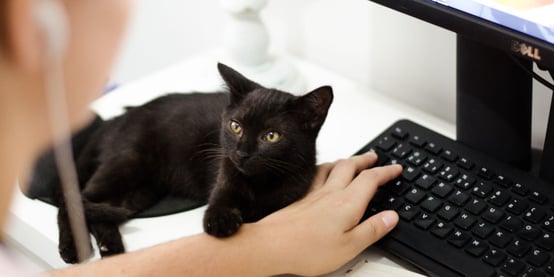Emergency vet visits: the unexpected roller coaster ride of pet parenthood.
We've all been there – one minute, your cat is reenacting Olympic gymnastics on your curtains, or your dog has mistaken a bee for a chew toy, and the next, you're caught in a whirlwind of worry, Google searches, and financial stress.
But fear not, intrepid pet parents. You have options when it comes to covering hefty emergency vet bills.
In this article, we’ll be diving into the average costs of emergency vet visits – plus, how to pay for them.
From unexpected splurges to sneaky ways to save, we’ll break down the dollars and cents of those unplanned pet predicaments, ensuring your four-legged companion receives the care they deserve while saving you money.
Common Types of Pet Emergencies

But first, what is a pet emergency?
There are many situations that might warrant a trip to the emergency vet. These can range from sudden injuries to serious medical conditions. If your pet is experiencing any one of these conditions, it may be time to take them to the emergency vet clinic:
- Trauma and accidents: This includes sudden trauma such as being hit by a car, taking a long fall, getting attacked by another animal, breaking a bone, severe burns, etc.
- Respiratory distress: If your pet is having difficulty breathing, is choking on an object, or is having an allergic reaction leading to respiratory issues, take them to the emergency vet immediately.
- Gastrointestinal issues: Ingestion of toxic substances or swallowing foreign objects (e.g., toys, bones) can lead to severe gastrointestinal issues.
- Cardiovascular emergencies: If you notice that your pet is having a rapid or irregular heart rate, appears to be in shock, or has collapsed/fainted, this warrants an emergency vet visit.
- Neurological emergencies: Signs of a neurological emergency may include seizures or convulsions, sudden disorientation, inability to walk, and/or head trauma.
- Poisoning: Consumption of poisonous plants, chemicals, or toxic foods (e.g., chocolate, grapes, onions) may require a visit to the emergency vet.
- Severe allergic reactions: Swelling of the face, eyes, or throat and difficulty breathing may all be signs of a severe allergic reaction.
- Persistent vomiting or diarrhea: If your pet has persistent vomiting or diarrhea, or bloody or black stools, it may be time to take them to the emergency vet.
Other examples of pet emergencies

There are other types of pet emergencies that can occur, though this list is far from exhaustive. If your pet is acting unusual, appears to have a serious injury, or is unresponsive, take them to the emergency vet immediately.
- Heatstroke or hypothermia: e.g. overheating in hot weather or exposure to extreme cold
- Reproductive emergencies: e.g. birthing complications, dystocia (difficult or obstructed labour)
- Urinary emergencies: Urinary blockages in cats, urinary tract infections, blood in urine
- Eye injuries: e.g. eye infection, trauma to the eye, corneal ulcers
- Lacerations and wounds: e.g. deep cuts or punctures, excessive bleeding
- Sudden lethargy or weakness: e.g. unexplained weakness or inability to stand, sudden loss of energy
- Severe pain: e.g. crying out in pain, reluctance to move or be touched
- Severe dental issues: e.g. broken teeth, infections in the mouth
How Much Does an Emergency Vet Visit Cost?
Generally, emergency vet visits can range from a few hundred dollars to several thousand dollars, depending on the severity of the condition, the required treatments, and the area in which you're located.
Here's a breakdown of potential emergency types, along with average cost ranges for each. US prices have been converted to Canadian dollars.
|
Emergency Type |
Examples |
Average Cost Range (CAD) |
|
Minor Injury or Illness |
Minor cuts, minor gastrointestinal upset |
$135 - $680 |
|
Moderate Injury or Illness |
Limb injuries, urinary tract infections |
$400 - $1,000 |
|
Severe Injury or Illness |
Fractures, severe gastrointestinal issues |
$1,000 - $2,000 |
|
Life-Threatening Condition or Surgery |
Trauma, major surgeries, critical illnesses |
$2,000 - $4,000+ |
|
Toxic Ingestion or Poisoning |
Ingestion of toxic substances, poisoning |
$680 - $2,700+ |
|
Cardiovascular or Respiratory Emergency |
Difficulty breathing, heart-related issues |
$680 - $2,000 |
|
Neurological Emergency |
Seizures, sudden disorientation |
$680 - $2,000 |
|
Gastrointestinal Blockage or Surgery |
Ingestion of foreign objects, gastric torsion |
$1,300 - $4,000+ |
|
Reproductive Emergency |
Birthing complications, dystocia |
$680 - $2,700+ |
|
Eye Injury or Infection |
Trauma to the eye, corneal ulcers |
$400 - $1,300 |
|
Severe Allergic Reaction |
Swelling, anaphylactic shock |
$400 - $1,300 |
|
Urinary Blockage in Cats |
Urethral blockage |
$1,000 - $2,700+ |
Please note that these are general estimates and actual costs can vary significantly. Also, these estimates do not account for aftercare, follow-up visits, medication costs, or potential complications that may arise during or after treatment.
Factors Affecting Emergency Vet Costs

As stated, the table above reflects the estimated average costs for different types of vet emergencies. It’s always best to contact emergency vet services in your area to get a more accurate estimate of veterinary costs for your pet.
Here are some factors that can affect how much you will pay for an emergency vet visit:
- Type of emergency
- Severity of condition
- Diagnostic tests needed
- Required treatment procedure
- Whether hospitalization is needed
- Medications
- Specialist consultations
- Location of the vet clinic
- Time of day
- Equipment required
- Type of facility
- Size and type of pet
- Unforeseen complications
- Anesthesia or sedation
- Follow-up care required
How to Pay for Your Emergency Vet Bill

Dealing with an unexpected pet emergency can be stressful. Not only are you worrying about your pet’s health, you may be anxious about facing a massive emergency vet bill.
Fortunately, you have several options when it comes to covering emergency vet costs. While some situations may require you to pay out of pocket, it’s always worth it to do your research and learn about various payment options.
Here’s how to pay for an emergency vet bill, including several cost-saving options:
Step 1: Assess the situation
Before panicking about an emergency vet bill, slow down and try to assess the situation.
Evaluate the severity of the emergency and determine if immediate veterinary care is necessary. Is your pet facing a life-threatening situation? Or, is this a condition that can be remedied through a regular vet visit?
If it is an emergency, seek emergency veterinary care right away. If you are not sure, call your local veterinarian for their expert opinion.
Step 2: Contact your veterinarian
Once you’ve determined your pet is facing a medical emergency, call your veterinarian or an emergency animal hospital to inform them about the situation. They can provide guidance on when and how to bring your pet in for treatment.
If possible, ask the vet for an estimated cost of the emergency treatment based on the information you provided. Keep in mind that they may not be able to provide an estimate until they evaluate your pet in person.
Step 3: Evaluate payment options
Most veterinary clinics and hospitals will inform you of the various payment options available. Sometimes, they may even provide payment assistance programs to pet parents in need.
Here are a few common payment methods for covering emergency vet bills:
- Cash, debit, or credit card: If you have the funds available, paying with cash, a debit card, or a credit card is a straightforward option.
- Pet insurance: Check your pet insurance policy to see if the emergency is covered. Contact your insurance provider to understand the reimbursement process and coverage limits.
- CareCredit: You may wish to consider applying for a medical credit card that offers special financing options for veterinary expenses such as CareCredit™*. Review terms, interest rates, and repayment options to ensure this is right for you.
- Payment plans: Inquire if the veterinary clinic offers payment plans to spread out the cost over time. Ask them about any associated fees or interest.
- Crowdfunding: If needed, you can explore crowdfunding platforms like GoFundMe™* to seek financial assistance from friends, family, or people on social media.
- Personal loans: Evaluate the option of taking out a personal loan from a bank or credit union. Understand the interest rates and repayment terms.
- Veterinary payment assistance programs: Research charitable organizations that provide financial assistance for pet emergency expenses. Ask your vet about eligibility and application requirements.
- Family and friends: Consider reaching out to family members or friends who might be willing to help financially. A little help can go a long way.
- Negotiation with the veterinary clinic: Depending on the situation and clinic policies, you might be able to negotiate a payment plan or discuss options for reducing costs. However, this may not always be possible.
Once you’ve evaluated the available payment options and have the estimated cost of treatment, it’s time to make an informed decision on how to proceed with your pet's care. If needed, discuss your concerns with the veterinarian or their staff. They may be able to provide helpful advice or assistance.
Step 4: Keep records
No matter what payment option(s) you choose, always keep a record of your emergency vet payments. Save copies of all communications, estimates, receipts, and payments. These records may be needed for future reference and potential pet insurance claims.
Step 5: Plan for the future
Once the emergency is resolved, take time to review how the situation was handled and explore ways to prepare for future pet emergencies.
This may include signing up for pet insurance, which can help you cover the costs of unexpected pet illnesses, surgeries, and other types of emergencies in the future. Furkin Pet Insurance helps pet owners cover up to 80% of eligible expenses, providing the care pets need and the cost savings you deserve.
How to Prepare for and Reduce Emergency Vet Costs

You can’t always anticipate a pet emergency, but there are steps you can take now to prepare for the future. By investing in your pet’s health, signing up for pet insurance, and creating a wellness budget, you can help prevent the occurrence and costs of a pet emergency.
Here are a few tips for how to prevent, prepare for, and/or reduce emergency vet costs:
Do your best to prevent pet emergencies
Reducing emergency vet bills involves proactive pet care, preventive measures, and knowing how to respond to potential health issues. Prevention is one of the best ways to avoid costly emergency vet bills.
Here are some strategies to help you minimize the likelihood of emergencies and manage costs:
- Maintain regular veterinary care: Schedule regular check-ups and vaccinations for your pet. Preventive care can catch health issues early, saving you from potential emergencies down the line.
- Keep up a healthy lifestyle: Provide your pet with a balanced diet, regular exercise, and mental stimulation. A healthy lifestyle can prevent obesity and reduce the risk of certain health problems.
- Pet-proof your home: Remove hazards and toxic substances from your home to prevent accidents and poisoning. Keep harmful plants, chemicals, and small objects out of reach.
- Supervise your pet: Supervise your pet during outdoor activities and walks to prevent accidents and altercations with other animals. Use a leash and harness to prevent them from wandering off, eating toxic materials, etc.
- Spay or neuter your pet: Spaying or neutering your pet can reduce the risk of certain health issues, such as certain cancers and reproductive emergencies.
- Keep up with dental care: Maintain good oral hygiene to prevent dental issues. These can lead to serious health problems if left untreated.
- Use parasite prevention: Use flea, tick, and heartworm preventives as recommended by your veterinarian to reduce the risk of parasitic infections.
- Learn pet first aid: Learn how to respond to minor injuries or illnesses to prevent the need for immediate vet visits.
- Microchip your pet: Microchip your pet to increase the chances of a safe return in case they get lost.
- Take pet safety classes: Attend pet safety and first aid classes to learn about, prevent, and prepare for pet emergencies.
Create a pet emergency budget

Building a pet emergency budget is another way to prepare for future vet bills. However, this is not foolproof, as you can’t always estimate the cost of emergency vet bills. For example, if you chose to save $50 a month, after two years you would have saved just $1200, yet many unexpected veterinary expenses can far exceed that amount saved. This also assumes you never had to tap into the “pet savings fund” for other unexpected expenses such as home or car repairs. Subscribing to comprehensive pet insurance is the best way to cover your pet’s needs and prepare for unexpected vet costs.
That said, having some money saved up could help you pay your deductible or cover out-of-pocket expenses before you’re reimbursed by your pet insurance company.
Here are some tips for creating a pet emergency budget:
- Consider establishing a separate bank account for pet emergency savings. Alternatively, you can stow away cash in a safe place, like a safe or piggy bank.
- Research and add up the average costs of common emergency situations and treatments in your area. This can include things like X-rays, bloodwork, wound treatment, and surgical procedures. Look at both minor and major emergencies to get a better idea of the potential range of expenses.
- Factor in your pet’s current health. If your pet has any pre-existing conditions or is prone to certain health issues, you might want to save more in anticipation of potential emergency care related to those conditions.
- If you have pet insurance, consider the deductible amount. Your emergency fund should ideally cover the deductible in case you need to file a claim.
- Assess your monthly budget and determine how much you can comfortably set aside for your pet's emergency fund. It's better to save a smaller amount consistently over time than to not save at all.
Sign up for Pet Health Insurance
Signing up for pet health insurance is one of the best ways to reduce the out-of-pocket costs for an emergency vet visit. At Furkin, you could get up to 80% of your total vet expenses covered during a pet emergency.
Furkin Pet Insurance helps ensure that your furry companions receive the necessary medical care they need during an emergency, without overwhelming you with emergency vet costs. Furkin's pet insurance coverage offers financial protection against many emergency situations, including unexpected accidents, illnesses, and injuries.
With quick reimbursement and flexible plans tailored to individual needs, Furkin Pet Insurance provides a safety net that allows you to focus on providing the best care for your pet!
Research your options
Worried that you can’t afford your emergency vet bill? You have options.
While we’ve already covered some common payment options (like payment plans, personal loans, or crowdfunding), there are a couple of alternative options to consider. We always recommend doing your research to look for programs, wellness plans, and discounts in your area or online.
Here are a few creative ways to cover emergency vet expenses:
- Plan a community fundraiser: Organize a community fundraiser or crowdfunding campaign to raise funds for your pet's emergency expenses. Engaging friends, family, neighbours, and local pet lovers can help spread the word and attract support.
- Check out pet-assistance charities: Research and reach out to pet-assistance charities, foundations, or nonprofit organizations in your area or online. Some organizations offer grants or financial assistance to pet owners in need.
- Barter or trade services: If you have skills or services that can be bartered or traded, consider offering your services in exchange for assistance with your pet's emergency bills. This could include pet-sitting, dog walking, or other services.
- Research local pet clubs: Check if there are local pet clubs, organizations, or associations that offer support for pet owners during emergencies. They might have resources or contacts that can help.
- Visit veterinary school clinics: Veterinary schools often have teaching clinics where students, under supervision, provide veterinary care at reduced costs. This could be an option for more affordable emergency care.
- Join an online pet community: Join online pet communities and forums where pet owners share experiences and advice. These communities might have resources or ideas for covering emergency costs.
Save Money with Emergency Pet Insurance
And there you have it, dear pet parent – a crash course in the realm of emergency vet visit costs. From weathering pet emergencies to wrangling those unexpected bills, you're now equipped with the resources you need to prioritize your pet’s health without burdening your pocketbook.
But before we wrap up, let's not forget our secret weapon in this budget battle: pet insurance.
With Furkin emergency pet insurance by your side, those unpredictable pet predicaments can become a lot more manageable. We cover a range of pet emergencies, from trauma and injuries, or allergies and illnesses. So go forth, pet parent, with the savvy savings tactics and handy sidekick of Furkin insurance. Because when it comes to your pet's health and your wallet's well-being, there's no adventure too wild to conquer.
*Furkin is not affiliated with CareCredit or GoFundMe and does not endorse or recommend these products.



